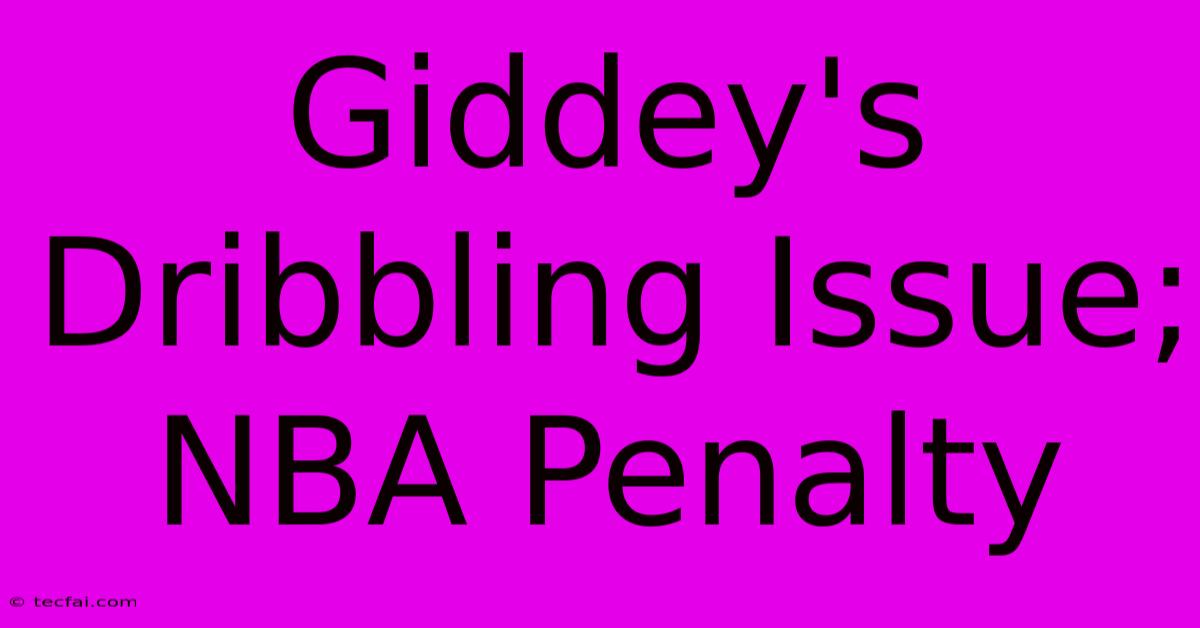Giddey's Dribbling Issue; NBA Penalty

Discover more detailed and exciting information on our website. Click the link below to start your adventure: Visit Best Website tecfai.com. Don't miss out!
Table of Contents
Giddey's Dribbling Issue: Navigating the NBA's Traveling Rules
Josh Giddey, the Oklahoma City Thunder's rising star, possesses a unique skillset that blends exceptional passing vision with a smooth, almost languid style of play. However, his unorthodox dribbling style has occasionally landed him in trouble with the referees, leading to traveling calls that frustrate fans and analysts alike. This article delves into the specifics of Giddey's dribbling mechanics, analyzes why they sometimes result in violations, and examines the broader context of traveling penalties in the NBA.
Understanding the Traveling Violation
Before dissecting Giddey's specific issues, let's define what constitutes a traveling violation in basketball. The NBA rulebook outlines traveling as "taking more than one step without dribbling the ball" after establishing a pivot foot. Essentially, once a player's pivot foot is set, they can only take one step before either passing, shooting, or resuming dribbling. The nuance lies in identifying the pivot foot and determining when a player has taken that crucial second step.
This seemingly straightforward rule often proves surprisingly complex in practice, especially with players who employ creative ball-handling techniques. Referees must make quick, subjective judgments under immense pressure, leading to occasional inconsistencies in calls.
Giddey's Dribbling Style: A Case Study
Giddey's dribbling is characterized by a low center of gravity, deliberate movements, and a tendency to gather the ball close to his body. While aesthetically pleasing and highly effective for creating passing lanes, this style occasionally pushes the boundaries of the traveling rule. He sometimes appears to gather the ball and then take multiple steps before initiating a shot or pass, triggering a travel call.
The challenge stems from the subtle nature of his movements. His shifts in weight and subtle adjustments aren't always easily discernible as a second step, leading to differing interpretations from referees and fans alike. He's not necessarily exhibiting a blatant violation, but rather a blurring of the lines within the rules.
The Impact of Officiating and Rule Interpretation
Inconsistency in officiating is a persistent issue in the NBA, and traveling calls are no exception. Referees have different thresholds for what constitutes a travel, and game situations influence their judgment. A tight game in the fourth quarter may lead to stricter enforcement, while a blowout might see more lenient calls. This inconsistency can be particularly frustrating for players like Giddey, whose style operates within the grey area of the rulebook.
The NBA's commitment to clarity in officiating is ongoing, with efforts to improve consistency and transparency. However, the subjective nature of the traveling rule will always leave room for debate and differing opinions.
Adapting and Improving: The Path Forward for Giddey
While Giddey's dribbling style is a significant asset, he could benefit from subtle adjustments to minimize traveling calls. Working with coaches and training staff to refine his footwork and ball-handling could lead to greater efficiency and reduce the frequency of violations. This process might involve:
- Conscious awareness: Developing a greater awareness of his pivot foot and the permitted steps.
- Drill work: Practicing drills specifically designed to improve footwork and reduce the likelihood of traveling.
- Film study: Reviewing game footage to identify patterns in his dribbling that lead to violations.
This process is about refinement, not a complete overhaul of his playing style. The goal is to maintain the fluidity of his game while minimizing unnecessary turnovers.
Conclusion: The Balancing Act of Skill and Rule Enforcement
Josh Giddey's dribbling situation highlights the inherent tension between individual skill and the interpretation of complex rules. His unique style, while highly effective, operates in a grey area, leading to inconsistent officiating. By focusing on subtle adjustments, Giddey can continue to thrive while minimizing the frequency of traveling calls. Simultaneously, the NBA's ongoing efforts to improve officiating consistency are crucial for creating a fair and predictable playing environment for all players. The challenge lies in finding a balance between allowing creative play and upholding the integrity of the game's rules.

Thank you for visiting our website wich cover about Giddey's Dribbling Issue; NBA Penalty. We hope the information provided has been useful to you. Feel free to contact us if you have any questions or need further assistance. See you next time and dont miss to bookmark.
Featured Posts
-
Inside Donald Trumps Jet
Nov 27, 2024
-
Algert Globals Nclh Investment Drop
Nov 27, 2024
-
Fact Check Morgan Freeman Death Rumors
Nov 27, 2024
-
Two Years Later Vanderpump Rules Reboot
Nov 27, 2024
-
1st Test Sa Vs Sl Wtc Championship Shape
Nov 27, 2024
